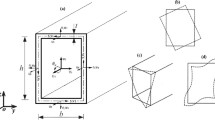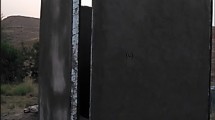Abstract
It has been demonstrated that the buckling-restrained steel plate shear wall (SPSW) is an efficient and economic lateral load-resisting system exhibiting high performance on initial stiffness, ductility, shear resistance, and energy dissipation capacity. In present study, a novel partially connected buckling-restrained SPSW is presented to reduce the stiffness requirement for the vertical boundary elements. Meanwhile, nonlinear finite element (FE) analysis is performed to evaluate the behavior of the proposed shear wall system so that a large expense of conducting additional test can be saved. The experimental results from the literature and the test conducted by the authors are used to establish the validation of FE models. Based on the validated FE models, a further extensive parametric study is carried out to investigate the effect of initial imperfection, stiffness of boundary elements, slenderness ratio (Height/Thickness) of the infill panel, aspect ratio (Height/Width) of the infill panel, RC cover panel thickness and bolt spacing on the behavior of the partially connected buckling-restrained SPSW.























Similar content being viewed by others
References
ABAQUS Version 14.1. (2014). ABABUS user’s manual, Hibbitt, Karlsson, and Sorenson Inc. (HKS), Pawtucket, R. I, USA.
ACI (American Concrete Institute). (2011). Building code requirements for structural concrete and commentary, ACI 318, Farmington Hills, MI, USA.
AISC (American Institute of Steel Construction). (2016). Seismic provisions for structural steel buildings, AISC314-16, Chicago, USA.
Astaneh-Asl, A. (2001). Seismic behavior and design of steel shear walls. In SEOANC Seminar, Structural Engineers Associate of Northern California, San Francisco, USA.
Bazant, Z. P., & Planas, J. (1998). Fracture and size effect in concrete and other quasibrittle materials. Boca Raton: CRC Press.
Behahanifard, M.R., Grondin, G. Y., & Elwi, A. E. (2003). Experimental and numerical investigation of shear plate shear wall. In Structural Engineering Report No. 254, Department of civil and Environmental Engineering, University of Alberta, Edmonton, Alberta.
Berman, J. W., & Bruneau, M. (2005). Experimental investigation of light-gauge steel plate shear walls. Journal of Structural Engineering, 131(2), 259–267.
CEB-FIP. (1993). CEB-FIP model code 90. London: Thomas Telford.
Chen, W. F. (1982). Plasticity in reinforced concrete. New York: McGraw-Hill.
Chen, S. J., & Jhang, C. (2006). Cyclic behavior of low yield point steel shear walls. Thin-walled Structure, 44(7), 730–738.
Choi, I. R., & Park, H. G. (2009). Steel plate shear walls with various infill plate designs. Journal of Structural Engineering, 135(7), 785–796.
Driver, R.G. (1997). Seismic behavior of steel plate shear walls, Ph.D. thesis, Department of civil and environmental engineering, University of Alberta, Edmonton, Alberta, Canada.
Gao, H. (2007). Experimental and theoretical studies on composite steel plate shear walls, Ph.D. thesis, Department of Civil Engineering, Tongji University, ShangHai, China.
Guo, Y., Dong, Q. L., & Zhou, M. (2009). Tests and analysis on hysteretic behavior of buckling-restrained steel plate shear wall. Journal of Building Structures, 30(1), 31–47. (in Chinese).
Hitaka, T., & Matsui, C. (2003). Experimental study on steel shear wall with slits. Journal of Structural Engineering, 129(5), 586–595.
Hitaka, T., Matsui, C., & Sakai, J. I. (2007). Cyclic tests on steel and concrete-filled tube frames with slit walls. Earthquake Engineering and Structural Dynamics, 36(6), 707–727.
Hordijk, D.A. (1991). Local approach to fatigue of concrete, Ph.D. thesis, Delft University of Technology, Delft, Holland.
Jin, S. S., Ou, J. P., & Liew, R. J. Y. (2016). Stability of buckling-restrained steel plate shear walls with inclined-slots: theoretical analysis and design recommendations. Journal of Constructional Steel Research, 117, 13–23.
Liu, Q., Li, G. Q., & Lu, Y. (2014). Experimental and theoretical study on the steel bound-columns with buckling restrained steel plate shear wall. In 7th European conference on steel and composite structures, Italy.
Robert, T. M., & Sabouri-Ghomi, S. (1992). Hysteretic characteristics of unstiffened perforated steel plate shear panels. Thin-Walled Structure, 14, 139–151.
Rots, J.G. (1988). Computational modeling of concrete fracture, Ph.D. thesis, Delft University of Technology, Delft, Holland.
Saenz, L. P. (1964). Discussion of‘Equation for the stress-strain curve of concrete’by P. Desayi and S. Krishan. Journal of American Concrete Institute, 61(9), 1229–1235.
Thorburn, L.J., Kulak, G.L., & Montgomery, C.J. (1983). Analysis of steel plate shear walls. In Structural Engineering Report No. 107, Department of civil and Environmental Engineering, University of Alberta, Edmonton, Alberta.
Timoshenko, S. P. (1936). Theory of elastic stability. New York: McGraw-Hill.
Wei, M. W., Liew, J. Y. R., Du, Y., & Fu, X. Y. (2017a). Seismic behaviors of partially connected buckling-restrained steel plate shear wall. Soil Dynamics and Earthquake Engineering, 103, 64–75.
Wei, M. W., Liew, J. Y. R., & Fu, X. Y. (2017b). Panel action of novel partially connected buckling-restrained steel plate shear walls. Journal of Constructional Steel Research, 128, 483–497.
Zhao, Q. H., & Astanch-Asl, A. (2007). Seismic behavior of composite shear wall systems and application of smart structures technology. Steel Structures, 7, 69–75.
Zhao, Q. H., & Astaneh-Asl, A. (2004). Cyclic behavior of traditional and innovative composite shear walls. Journal of Structural Engineering, 130(2), 271–284.
Acknowledgements
This research work is supported by the China Scholarship Council (CSC) (Grant No. 201506120268). The writer wishes to thank Prof. J.Y. Richard Liew for his assistance in the writing of this paper. However, any opinions, findings, conclusions and recommendations presented in this paper are those of the authors and do not necessarily reflect the views of the sponsors.
Author information
Authors and Affiliations
Corresponding author
Rights and permissions
About this article
Cite this article
Wei, MW., Richard Liew, J.Y. & Fu, XY. Nonlinear Finite Element Modeling of Novel Partially Connected Buckling-Restrained Steel Plate Shear Walls. Int J Steel Struct 19, 28–43 (2019). https://doi.org/10.1007/s13296-018-0073-3
Received:
Accepted:
Published:
Issue Date:
DOI: https://doi.org/10.1007/s13296-018-0073-3




